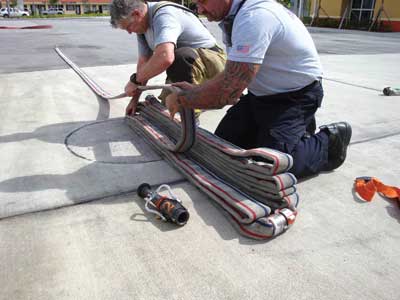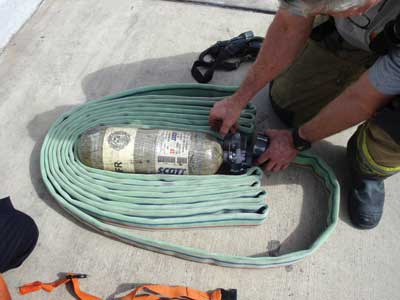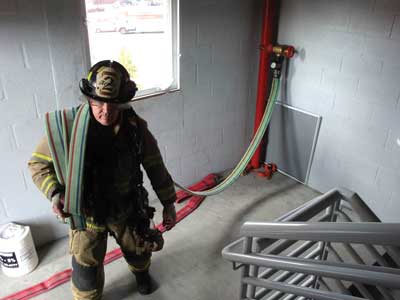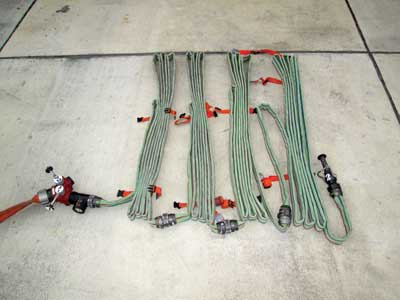BY BILL GUSTIN
There is an age-old axiom in the fire service that more lives are saved by properly positioned hoselines than by all the ladders in a fire department. That is definitely true when it comes to fires in high-rise buildings because it is practically impossible for firefighters to rapidly control a fire and simultaneously rescue occupants. A protect/shelter-in-place strategy is the only option in high-rise buildings where a large number of the population are elderly and must use wheelchairs and walkers for mobility (photo 1).
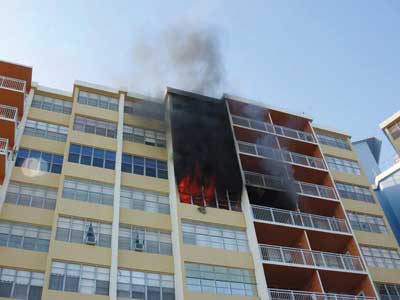 |
| (1) The majority of this building’s occupants are elderly and use wheelchairs and walkers; evacuation by stairs was not an option. Miami-Dade protected their lives by rapidly extinguishing the fire while they remained in their apartments. (Photo by Eric Baum.) |
Imagine the fear and anxiety that the physically impaired must feel when the fire alarm system broadcasts a recorded message over public-address speakers advising them that there is a fire in the building, they are to evacuate, and they are not to use the elevators. Consider also that in some buildings, occupants physically capable of taking stairs may not evacuate because they have grown indifferent to the fire alarm because they have experienced a large number of false alarms and minor cooking fires that activated the smoke detectors. Fire department public education programs aim to teach occupants of multifamily buildings what to do in a fire. Similarly, fire safety instructions and a floor plan are posted on the inside of hotel room doors.
Generally, the instructions advise occupants to know the location of the closest evacuation stairway and to carefully feel the door to the public hallway for heat before cautiously opening it to evacuate when the fire alarm sounds. If occupants encounter heavy smoke in the hallway, they are advised to remain in their room or apartment and call 911 or the building’s emergency number and await rescue by the fire department. The reality is that the fire department these residents think is coming to their rescue may not have the resources in its first-alarm high-rise assignment to control the fire and physically remove them from harm—at least, not in a timely fashion.
Theoretically, rescue takes priority over fire control: “Life before property.” That sounds good but, in reality, the fire is not going to take a time out while firefighters perform search and rescue. When firefighters cannot take occupants away from harm in a high-rise fire, then they must take harm away from the occupants. This is most effectively accomplished by rapidly locating the fire, stretching a hoseline from a standpipe outlet, and getting water on the fire. Fire control achieves a greater good for a greater number of residents than physically rescuing them by ladder or dragging them down a smoke-filled hallway. Rapid fire suppression achieves rapid reduction in the production of heat, smoke, and toxic gases that threaten occupants.
Clearly, the protection of life is a fire officer’s top strategic priority, but in the case of high-rise fires, implementing a life-protection strategy is often most effectively accomplished by performing fire control tactics. Accordingly, the first companies to arrive at a high-rise building fire and ascend to the reported fire floor with hose and tools are on a life-saving mission. They must control the fire that threatens the occupants they cannot rapidly rescue. Every other function on the fireground, however important, is secondary. For example, establishing lobby control early in an incident is important but not when it commits first-arriving personnel to a point that it diminishes their ability to begin fire-control operations. Early establishment of lobby control and other, albeit important, functions at a high-rise fire may look good on an incident command checklist and sound good on the radio, but they do not get water on the fire.
Some fire departments do not permit first-arriving companies to use elevators to reach the upper floors of a high-rise building if there is a possibility that the elevators could malfunction and arrive at the fire floor unexpectedly. Clearly, using elevators in a high-rise building while it is on fire is inherently dangerous. Firefighters can make their ascent safer by placing the elevators on “phase 2” firemen service and checking the hoistway for smoke and water before they ascend and then again on precautionary stops. Additionally, until the exact fire floor is known, firefighters should never ascend fewer than two floors below the reported fire floor. Although these and other measures will make the use of elevators in a high-rise fire safer, they will never make elevators entirely safe or guarantee that they will not take firefighters to the fire floor.
Every function on the fireground should be preceded by a risk-benefit or risk-reward analysis. When firefighters begin their career, they take an oath to protect life and property and understand that they are entering an inherently dangerous profession. Professional fire officers, whether career or volunteer, will place themselves and their personnel at very little risk when there is little to gain—”risk little to save little.” Conversely, firefighters will operate at a higher level of acceptable risk when there is a strong possibility that they can save civilian lives—”risk a lot to save a lot.”
First-arriving firefighters who take elevators to rapidly reach and begin to control a fire on an upper floor of a high-rise building place themselves at greater risk than if they ascend the stairs. There is no argument there. The risk to firefighters, however, is justified because civilian lives are also at risk, and their survival depends on firefighters rapidly controlling a fire the civilians cannot escape.
Effective, professional standpipe operations begin with preparation. This article examines the reasons such preparation measures as flow testing and building and standpipe system familiarization through prefire planning are critical in selecting the proper hose, hose bundle configuration, and accessories for standpipe operations.
HOSE EVOLUTIONS FOR STANDPIPE OPERATIONS
Some hose evolutions are building-specific, devised for a particular type of building or building design. The time to select the most effective hose evolution for a building is during prefire planning, not when smoke is showing at 0300 hours. Just because a building has a standpipe doesn’t mean firefighters have to use it. Consider a fire on the lower floor of a high-rise building that has stairways that discharge directly to the outside, have stairwell openings large enough for hose, and are a short distance from where fire apparatus can be positioned. In this case, stretching hose from an apparatus and up a stairwell may be faster than connecting to a standpipe. High-rise buildings with exterior hallways are quite common in “Sunbelt” regions. No hose evolution will get water on a fire on a lower floor of an exterior hallway building faster than dropping a rope bag to the ground and hoisting a hoseline. Consider also the reliability of using hose stretched and supplied directly from fire department pumpers compared with the uncertain reliability of a building’s standpipe system.
1¾-Inch Hose
When a fire department decides on the size of hoseline for standpipe operations, it must carefully consider the occupancy, age, and fire protection systems of the buildings in its jurisdiction. Selecting hose for standpipe operations also necessitates a thorough understanding of the capabilities and, more importantly, the limitations of each size of hose being considered. Although 1¾-inch hose has been widely demonized for use with standpipes, many fire departments in North America use it. It’s interesting that there are instructors and authors who advocate that the size of hose for standpipe operations should never be smaller than 2½-inch when their own departments use 1¾-inch hose.
The most common and valid argument against 1¾-inch hose for standpipe operations is its relatively low gallons-per-minute (gpm) flow and high friction loss. Fire departments that use 1¾-inch hose for standpipe operations should not further reduce its limited flow capabilities by pairing it with combination nozzles designed to operate at 100 pounds-per-square-inch (psi) nozzle pressure. The only worse choice for standpipe use is “automatic” nozzles with an internal spring that maintains an artificially high nozzle pressure over a range of flows. “Low-pressure” combination nozzles designed to flow their rated capacity at 50 psi are a vast improvement over conventional 100-psi nozzles, but they still are not a good choice for standpipe operations because they have a tendency to clog with debris that finds its way into standpipe systems.
The flow capabilities and friction loss of 1¾-inch hose vary widely across manufacturers and grades. One reason for the disparity is that not all hose sold as 1¾-inch hose has an inside diameter of 1¾ inches. Some actually have an inside diameter as large as 1.88 inches. Remember from hydraulics class that a slight increase in diameter results in a significant increase in cross-sectional area and a significant decrease in friction loss. Additionally, hose expands when it is pressurized, increasing its inside diameter. Some hose expands more than others. Not all 1¾-inch hose is suitable for standpipe use. For example, some low-end hose manufactured in China has such high friction loss that standpipe use is out of the question.
The age of the hose also has a significant bearing on its flow capabilities because of improvements in fire hose over the years. For example, in the 1990s, my department purchased 1¾-inch hose that was at the top of the product line of a manufacturer of high-quality hose. At that time, our flow tests indicated a friction loss of 40 psi per 100 feet when flowing 185 gpm. Today, that same grade of hose from the same manufacturer flows 185 gpm at 25 psi friction loss per 100 feet. A fire department that uses 1¾-inch hose for standpipe operations must judge its capabilities and limitations based on flow testing its specific brand, model, and age of hose; generic friction loss charts are practically meaningless.
Under certain conditions, you can safely and effectively use 1¾-inch hose for standpipe operations. Success with it is not just dumb luck. Say, for example, that every standpipe-equipped building in a department’s jurisdiction is a modern, fully sprinklered, compartmented residential occupancy. Additionally, all buildings with standpipes were constructed after 1993, the year that National Fire Protection Association (NFPA) 14, Standard for the Installation of Standpipe and Hose Systems, changed the minimum pressure requirement for standpipe outlets from 65 psi to 100 psi. After careful consideration, the department decided that high-quality 1¾-inch hose equipped with a 15⁄16-inch smooth bore nozzle will be its primary, but not only, hoseline for standpipe operations.
This department did its homework by flow testing standpipes in its jurisdiction and determined that available standpipe outlet pressures are not much above 100 psi; hence, it determined that 200 feet is the maximum length that it can stretch 1¾-inch hose. An outlet pressure of 105 psi, read on an in-line gauge while the nozzle is fully opened and flowing, is sufficient to flow 185 gpm through 200 feet of 1¾-inch hose at a nozzle pressure of 50 psi through a 15⁄16-inch tip. This psi is also sufficient to overcome 50 psi friction loss (25 psi per 100 feet) and five psi for the pressure lost from elevation when connecting to an outlet on the floor below the fire. Stretches longer than 200 feet of 1¾-inch hose will result in excessive friction loss and an inadequate stream and must be “filled out” by connecting 2½-inch hose between the standpipe outlet and the 1¾-inch hose.
Notice in the preceding paragraphs that there was never any mention of staffing as a criterion for choosing 1¾-inch hose for standpipe operations. A fire is an unsympathetic chemical reaction that doesn’t care if a fire department does not have the staffing to operate hoselines larger than 1¾-inch. The fire will continue to grow until it has consumed the available fuel or oxygen or it is suppressed by a sufficient flow of water from the proper size hoseline.
My company, as well as the Los Angeles (CA) and the Orlando (FL) fire departments, uses two-inch hose with 1½-inch couplings as the primary hose for standpipe operations. In Orlando, the hose is paired with a 11⁄8-inch smooth bore nozzle, which flows 250 gpm at 45 psi nozzle pressure. This results in a friction loss of 35 psi per 100 feet of hose. My company has been evaluating two-inch hose with 2½-inch couplings for more than a year and has been impressed with its performance because it approximates the flow of 2½-inch hose and has a mobility similar to 1¾-inch hose. A standpipe outlet pressure of 100 psi will achieve a flow of 250 gpm through 200 feet with a 11⁄8-inch smooth bore nozzle. That’s at a friction loss of 25 psi per 100 feet, 45-psi nozzle pressure, and five psi for the elevation pressure lost by connecting to an outlet on a floor below the fire.
Many fire departments use hose designed specifically for standpipe use. This hose is generally lighter weight than conventional hose and is available in 50-, 75-, and 100-foot sections. Lightweight hose is easier to carry and handle than conventional hose, but the reduction in weight may be at the expense of durability. Since lightweight high-rise hose may not have the heat or abrasion resistance of conventional hose, it’s a good idea to use it only for standpipe operations.
When There’s No Substitute for 2½-Inch Hose
Fire departments that use hose smaller than 2½-inch for standpipe operations must recognize conditions, however rare, that are beyond the suppression capabilities of their hoselines. Further, they must train to have the capability to deploy 2½-inch hose. There are two primary reasons hose smaller than 2½ inches in diameter can fail to effectively control a high-rise fire: inadequate standpipe system pressure or a volume of fire that exceeds the department’s suppression capabilities. Following are some examples.
Buildings Under Construction. Buildings are never more vulnerable to fire than when they are under construction, and high-rise buildings are no exception. During construction, propane for space heaters, construction debris, and wood concrete forms combine for a dangerously high fire load at a time when a building’s fire protection systems are the least capable of controlling a serious fire. In many jurisdictions, the code requires just one operating standpipe that, hopefully, is capped near the highest completed floor. This standpipe is installed long before the building’s fire pumps and most likely is dry. Sprinkler systems will also be out of service until the system is completed and the building is heated so that water does not freeze in the pipes. In most cases, the only water supply for the standpipe is provided by a temporary fire department connection, which may be difficult to locate because it may be relocated during construction (photo 2). Temporary FDCs are notorious for being inaccessible, improperly installed, and damaged by construction equipment. Imagine a high-rise building under construction with floor areas measuring several thousand square feet and just one standpipe. This could require a hose stretch of several hundred feet, resulting in high friction loss. In buildings under construction, the combination of a high fire load, low system pressures, and long stretches makes the use of 2½-inch hose essential.
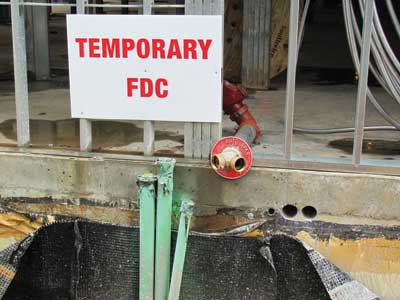 |
| (2) This high-rise building, which is under construction, is required to have only one functioning standpipe, which is supplied by a temporary fire department connection. (Photo by Mac McGarry.) |
Pressure-Reducing Valves (PRVs). Pressure-reducing 2½-inch standpipe outlet valves are installed in standpipe systems to prevent outlet pressures from exceeding 175 psi. PRVs reduce both static and residual pressures by means of a floating valve that “throttles” from a fully opened to a fully closed position. As I have explained in previous articles (“Changes in High-Rise Buildings: Is It Time to Change Your Procedures?” http://bit.ly/1khApOG and “Testing Pressure-Reducing Valves,” http://bit.ly/1byHoxO), corrosion may cause a floating valve inside a PRV to freeze in the closed position, resulting in no flow or failure to fully open, resulting in a reduced flow. To ensure that PRVs deliver adequate pressure, they must be flow tested in accordance with NFPA 25, Standard for the Inspection, Testing, and Maintenance of Water-Based Fire Protection Systems. Flow testing “exercises” the floating valve, which significantly increases the reliability of PRVs.
PRVs may also fail to deliver the proper pressure if they were installed on the wrong floor or adjusted improperly. Firefighters who must gamble on PRVs that have not been properly tested and maintained are strongly advised to use 2½-inch hose and smooth bore nozzles because they might not deliver sufficient pressure to overcome the friction loss in smaller-diameter hose or achieve a nozzle pressure above 40 to 50 psi.
Wind-Driven Fires. Wind entering an open window of a fire apartment or an office and exiting though its open door can result in blowtorch conditions in the public hallway. Firefighters will find it extremely punishing or impossible to advance a hoseline from a stairwell to the fire under these conditions, especially if they are using a hoseline smaller than 2½ inches because of insufficient flow and the reach of its stream. Although 2½-inch hoselines are safer than smaller-diameter hoselines and are more effective against a wind-driven fire, it is very important to understand that no number of 2½-inch hoselines or portable master stream devices that are advanced or operated from stairwells will suppress an intense wind-driven fire.
Smoke Towers. It is not always possible to advance hose from the stairway closest to the fire. Stretching from a more distant stairway can require significantly more hose and necessitate the use of 2½-inch hose to avoid excessive friction loss. For example, some stairwells in commercial and residential high-rise buildings are designed as smoke towers to keep them clear of smoke. Smoke towers consist of a smoke shaft and louvers in a vestibule between the stairwell and the public hallway. Occupants escaping smoke in a hallway first enter the vestibule before entering the stairwell. Smoke entering the vestibule will flow into the shaft and vent outside the building instead of into the stairwell. In warm climates, smoke towers commonly have an open-air balcony instead of an enclosed vestibule and smoke shaft. Occupants fleeing a smoke-filled hallway first enter the balcony that allows the smoke to vent to the exterior before they enter the stairwell. Smoke towers are excellent escape stairwells for occupant evacuation because they remain relatively clear of smoke, but they can be dangerous for firefighters who use them as an attack stairwell. The smoke shaft or open balcony of a smoke tower creates an area of low pressure that can draw fire toward firefighters. The flow of fire and heat toward a smoke tower is greatly intensified in a wind-driven fire and can be deadly for firefighters in its flow path.
Now consider a high-rise building with two stairways that are 200 feet apart, one at each end of a center hallway. The east stairway is enclosed and pressurized, which makes it a good choice for an attack stairway because the pressurization will reduce the amount of smoke that will flow into the stairwell when its door to the fire floor is opened to advance hose to the fire. The west stairway is a smoke tower, which makes it an excellent choice for an evacuation stairway for occupants because it will remain relatively clear of smoke.
Now, say Murphy’s Law is in effect and a fire starts in an apartment within a few feet of the west stairwell smoke tower and, to make matters worse, fleeing occupants left the door to the public hallway open. If firefighters choose the west stairwell for their attack because it is closest to the fire apartment, there is a strong possibility that they will be driven back into the stairwell by a blast of heat that will flow to the low pressure of the smoke shaft. After they regroup, they attempt another advance, this time from the east stairwell, 200 feet from the fire apartment. Their stretch could be as long as 300 feet—that’s 50 feet from the standpipe outlet on the floor below the fire to the fire floor landing, 200 feet from the east stairwell to the door of the fire apartment, and an additional 50 feet to the nozzle’s stream to reach every point in the fire apartment. A long stretch such as in this scenario may necessitate the use of 2½-inch hose to avoid excessive friction loss and inadequate flow.
Large Fire Areas. Commercial high-rise buildings are a significant fire problem because they typically have large, undivided floor areas that can allow a fire to grow beyond the suppression capabilities of multiple 2½-inch handlines and portable master stream devices.
Partitions between offices rarely extend above the ceiling, allowing the space above to be used as a return air plenum and a space for air supply ductwork and telecommunication cables. Commercial high-rise buildings are designed to maximize rentable tenant space. This is achieved with center core construction. Photo 3 is of an unfinished floor of a center core high-rise office building. The stairs, elevator shafts, ductwork, plumbing, and electrical bus ducts are all contained in the center core. Notice that the air supply ductwork has not been extended because the floor plan of a future tenant is not known. Louvers in the center core are for heating, ventilation, and air-conditioning (HVAC) air return; smoke-control system pressurization; and smoke exhaust. They will not be connected to ductwork; rather, they will use the space between the ceiling, when it is installed, and the floor above for a plenum.
 |
| (3) This is an unfinished floor of a center-core high-rise office building. HVAC ductwork will be extended and partitions reaching only to the ceiling will be installed to meet the needs of a future tenant. Louvers in the core are for air return and exhaust and pressurization of the smoke-control system, which will use the undivided space between the ceiling and the floor above as a plenum for air movement. (Photo by Eric Goodman.) |
Residential buildings can also challenge firefighters with large-area fires that necessitate 2½-inch hoselines. For example, condominium associations in Florida have been granted a grace period until 2019 to install full sprinkler systems in their buildings. Consequently, the Atlantic and Gulf coasts are lined with luxury high-rise condominium buildings with no sprinkler protection. Many units in these buildings are larger than 2,500 square feet, particularly on upper floors. A fire in a large, unsprinklered condominium unit driven by a strong sea breeze will likely challenge the suppression capabilities of 2½-inch hose and overwhelm smaller-diameter hoselines.
Atria. An atrium is a large shaft that passes through three or more levels and is typically the largest single undivided area in a building. Because atria have the potential to spread smoke and fire vertically to every floor in a building, codes require sprinklers, smoke-detection and smoke-control systems, and fire-rated separation between an atrium and most floors surrounding it (three floors are permitted to be “open” to the atrium as long as smoke control is provided for them). Smoke control and sprinkler systems are engineered specifically for the height and area of a particular atrium and the anticipated fire load and smoke production of its contents and furnishings. Since the fire safety of an atrium is predicated on properly designed and operating systems, the failure of any one of them could result in a fire that necessitates the use of 2½-inch handlines and portable master stream devices. Consider an atrium in a high-rise hotel. The sprinkler discharge density, in terms of gpm/square feet and the capacity of the smoke-control system, in terms of cubic feet per minute, was designed for the fire load of the lobby, cocktail lounge, and restaurant on the ground floor of the atrium. What if the hotel hosts a convention or trade show and the lobby is filled with exhibition and sales booths (despite fire code restrictions on fuel loads in atria)? Could this increase the fire load beyond the suppression capability of the sprinkler system and produce volumes of smoke faster than the smoke-control system was designed to exhaust?
Some codes allow a reduction in fire-rated separation between an atrium and surrounding floors when an atrium is fully sprinklered. Additionally, windows may be permitted in walls surrounding an atrium if they are protected by closely spaced sprinkler heads on both sides of the glass. Now, consider that sprinklers on each floor surrounding an atrium are controlled by pressure-reducing zone or floor control valves that haven’t been flow tested since they were installed decades ago. Fire protection systems that fail to operate because of a lack of maintenance and testing can allow a fire in an atrium to rapidly intensify, necessitating 2½-inch hoselines. Streams from a hoseline smaller than 2½ inches may not have the suppression capability or vertical reach necessary to control an advanced fire in an atrium.
BUILDINGS CONSTRUCTED BEFORE 1993
In response to the disastrous high-rise fire at One Meridian Plaza in Philadelphia, the 1993 edition of NFPA 14 increased the required minimum standpipe outlet pressure from 65 psi to 100 psi. Fire departments with high-rise buildings constructed before 1993 should carefully consider if standpipe pressures are adequate to supply hose any smaller than 2½ inches in diameter. They should also question the condition of standpipes in older buildings. When were they last flow-tested? Are pipes clogged with sediment and mineral deposits? Can the FDC and pipes withstand the pressures necessary to adequately supply hose smaller than 2½ inches? When the pressure and condition of an old standpipe system is in question, it’s a good idea to use 2½-inch hose.
“DON’T WORRY; IT’S SPRINKLERED”
Any firefighter who says, “Don’t worry. We’ll never have a serious fire in that high-rise building because it’s sprinklered,” has never had to fight a nasty, wet, smoky dangerous fire in a sprinklered building. Sprinklers have a remarkable record of success and are without question the most effective means of preventing catastrophic fires in high-rise buildings, but they do not guarantee that there will not be a serious fire in a building and, in a sense, can make some aspects of firefighting more difficult. For example, when a building is fully sprinklered, the building code may allow a “trade-off” or variance that increases the maximum travel distance to the closest exit stairway to 200 feet. Consequently, stairways in a fully sprinklered residential building can be as much as 400 feet apart.
Sprinkler protection definitely makes a building safer from fire, but allowing stairwells to be spaced at such a great distance can require an extraordinarily long stretch. Additionally, the cooling effect of sprinklers on smoke can cause negative buoyancy, contaminating floors below the fire with smoke. Sprinkler systems engineered for the typical fire load of residential occupancies are hydraulically designed to discharge 0.1 gpm per square foot. That flow is sufficient to control a fire in a normally furnished apartment until firefighters can complete extinguishment with hoselines. It may not, however, control a fire set deliberately with an accelerant or in “pack rat” conditions, when the designed fire load is exceeded by packing the apartment from floor to ceiling with furniture, clothing, and newspapers. A friend of mine, an engine company lieutenant, rescued an elderly man and his wife in an extremely smoky fire in a fully sprinklered building. The fire was allowed to intensify because a large entertainment center blocked the only side wall sprinkler head in the room of origin.
In older high-rise buildings, only the common areas such as hallways and tenant storage areas are required to be retrofitted with partial sprinkler protection, leaving the apartments unprotected. Sprinkler systems are subject to mechanical failure and human error—for example, when building maintenance or security personnel prematurely close valves. Sprinklers in a high-rise building depend on properly operating fire pumps to overcome pressure loss from elevation and may fail to control a fire if the systems have not been tested in accordance with NFPA 25.
HOSE BUNDLES AND STANDPIPE EQUIPMENT
Fire departments should evaluate a variety of hose bundles under realistic conditions and then choose what works best for them. Remember to consider what neighboring departments are using if your department is participating in a countywide high-rise plan. Evaluate hose bundles on whether you can fold and deploy them easily and if you can carry them “hands free” over your shoulder or self-contained breathing apparatus (SCBA) cylinder and its weight, which you must evaluate by carrying the bundle up several flights of stairs. Evaluate weight by considering a bundle’s total weight and how it is distributed. For example, it is easier to carry two 50-foot bundles over each shoulder than one 100-foot bundle on one shoulder. An important requirement for some departments will be a bundle’s ability to play off your shoulder or forearm as you stretch it up stairs and around corners. Additionally, some departments will have to evaluate high-rise bundles for nonstandpipe applications. For example, it is not uncommon for departments to use standpipe bundles to extend preconnect hoselines or use them as a “leader line” connected to a gated wye or a 2½-inch nozzle. Remember to consider the durability of lightweight hose.
In another article, I will examine the deployment of a 100-foot flat bundle of two-inch hose with 1½-inch couplings and 50-foot Denver Loads of 2½- and two-inch hose with 2½-inch couplings. The flat bundle is folded by coupling, and two stacks of 50-foot hose are strapped together (photo 4). The Denver Loads are folded beginning with the male coupling so the hose will play off a firefighter’s shoulder or forearm (photos 5, 6).
At a recent high-rise conference in Pensacola, Florida, Captain Kevin Story of the Houston (TX) Fire Department demonstrated hose bundles that his engine company is evaluating. Fifty-foot sections of two-inch hose with 2½-inch couplings are folded in an accordion configuration with both male and female couplings accessible at one end and connected to protect the threads (photos 7, 8). You can carry the bundles hands free over the shoulder or on an SCBA cylinder. Deploy them by connecting them on the floor below the fire and stretching them down the hallway in a “U” or “W” configuration to eliminate kinks when they are charged and to facilitate a smooth advance. You can also deploy them from your shoulder or forearm. These bundles definitely meet the criteria of simplicity in folding and deployment.
Appliances and equipment for standpipe operations are commonly carried in an “accessory bag.” The contents will vary depending on local requirements, but the bag generally includes spanner wrenches, a pipe wrench, a valve wheel wrench, a spare valve wheel, vise grips, an in-line gauge, an elbow, a wire brush for corroded outlet threads, and special rods or other tools used to adjust pressure-reducing standpipe outlet valves. My company’s bag also contains small bolt cutters to cut chains securing sprinkler floor or zone control valves in the open position, extra door chocks, door latch straps made from old inner tubes, and a set of Allen wrenches to remove pressure-restricting devices that keep standpipe outlet valves from being fully opened (photo 9). My department issues each company a five-foot “pigtail” section of three-inch hose and a 2½ × 2½ × 2½ gated wye for standpipe operations. The pigtail section is essential for connecting an in-line gauge and gated wye in old high-rise buildings that do not have 2½-inch standpipe outlets in the stairwells; they are in hose cabinets in the hallways.
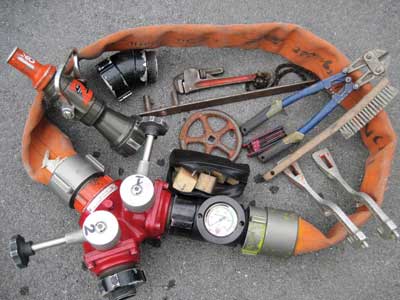 |
| (9) This standpipe accessory bag contains three-inch “pigtail” hose, a gated wye, an inline gauge spare nozzle, bolt cutters, spanner wrenches, an elbow, a pipe wrench, a valve wheel wrench, a spare valve wheel, door chocks, a wire brush, and Allen wrenches for removing pressure-restricting devices. (Photo by Eric Goodman.) |
The gated wye is used for connecting a second hoseline and, more importantly, extending the first when it is too short to reach the fire. Stretching short in a residential high-rise building is an avoidable mistake that you can prevent by being familiar with the floor below the fire. Firefighters, however, are at a disadvantage at fires in office high-rise buildings because every floor is likely to be different to suit the needs of each tenant. Consequently, firefighters may not reach the fire either because they didn’t stretch sufficient hose or they did not know the most direct path to the fire.
Departments will have to decide for themselves if connecting a second hoseline to a gated wye or water thief is right for them. One argument against connecting a second line to a gated wye is that doing so may exceed the flow capacity of a 2½-inch standpipe outlet, especially when pressure-reducing valves are used. Another argument against using a gated wye is that it is heavy. My company resolved this problem by redistributing the weight of the pigtail section, gated wye, and in-line gauge. We took them out of our accessory bag, connected them in a loop, and wore them over our shoulder like a bandolier (photo 10).
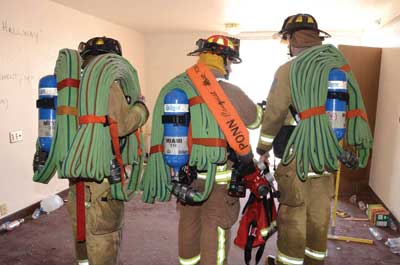 |
| (10) The “pigtail” hose, wye, and in-line gauge are connected in a loop to redistribute the weight in the accessory bag. (Photo by Eric Goodman.) |
MUTUAL AID
Few fire departments outside of the big cities in North America have the resources to handle a working high-rise fire by themselves and must depend on mutual aid. In many areas, small departments have collaborated in developing excellent regional or countywide high-rise firefighting plans. Departments participating in such a plan operate at a high-rise fire in their jurisdiction or as mutual aid as if they were one large department. The success of a high-rise mutual-aid agreement depends on departments being able to work and communicate with each other and the interoperability of their equipment. Fire departments participating in a high-rise mutual-aid agreement should, therefore, strive to use the same size hose for standpipe operations, configure it in the same type of bundle, and use the same nozzles and other equipment.
BILL GUSTIN is a 41-year veteran of the fire service and a captain with the Miami-Dade (FL) Fire Rescue Department. He began his fire service career in the Chicago area and conducts firefighting training programs in the United States, Canada, and the Caribbean. He is a lead instructor in his department’s officer training program, is a marine firefighting instructor, and has conducted forcible entry training for local and federal law enforcement agencies. He is an editorial advisory board member of Fire Engineering and an advisory board member for FDIC. He was a keynote speaker for FDIC 2011.
Fire Engineering Archives
